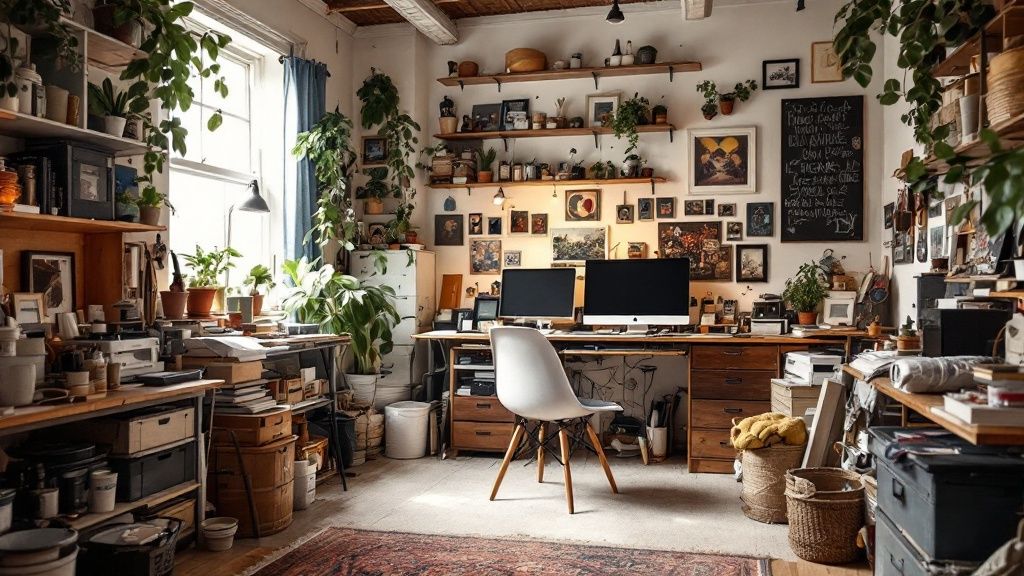Understanding the Power of Personal Rebranding

Personal rebranding is essential for career growth and professional success. It involves thoughtfully reshaping how others see you to match your current skills, goals and values. By carefully managing your professional image, you can open new doors and create better opportunities.
Recognizing the Need for a Change
The first step in successful rebranding is knowing when it's time for a change. Your current professional image may no longer reflect who you are, especially if you've gained new skills, switched careers, or outgrown your previous role. Being aware of these personal changes helps identify when rebranding makes sense.
External factors can also signal it's time to refresh your professional brand. Industry shifts, changes in your target audience, or past reputation issues may require updating how you present yourself. Paying attention to these external signs helps maintain a strong professional presence.
Dispelling Common Rebranding Myths
Many people avoid rebranding because they worry it seems fake or superficial. However, authentic rebranding aligns your outward image with your actual growth and values – it's about showcasing your true self, not creating a false persona.
Some think rebranding is a one-time project, but it's really an ongoing process. As you grow and change, your brand should evolve too. This means regularly reviewing and adjusting things like your online presence, networking approach, and professional story. For perspective, 74% of S&P 100 companies rebrand within their first seven years to stay aligned with their evolving goals. Learn more about rebranding statistics here.
Understanding the ROI of Personal Rebranding
While the benefits aren't always immediately measurable, personal rebranding can significantly boost your career. A well-crafted personal brand helps increase your visibility, access better opportunities, and earn more. It also helps build stronger professional relationships and establish credibility in your field.
Smart rebranding focuses on long-term career growth, not short-term trends. This means carefully developing a brand that shows your real value and connects with your target audience. When done thoughtfully, personal rebranding helps you tell your career story effectively and create a path to greater professional success.
Creating Your Strategic Rebranding Roadmap
Rebranding yourself takes careful planning and strategy. Think of it like a journey – you need a clear destination and map to reach your goals. A good rebrand requires several key steps: doing a thorough brand audit, getting feedback, setting specific goals, and measuring your progress.
Conducting a Thorough Brand Audit
A brand audit helps you understand how others currently see you. Take an honest look at your entire professional image – both online and offline. Review your social media profiles, website content, past work samples, and professional network. This assessment reveals your strong points, weak areas, and ways to stand out from others in your field.
Gathering Actionable Feedback
While self-assessment matters, outside perspectives provide crucial insights. Ask mentors, colleagues and past clients for their honest input about your professional brand. Use specific questions like "What do you see as my key strengths?" and "Where could I improve?". Their feedback helps identify blind spots and refine your rebranding approach.
Setting Measurable Objectives
Clear, measurable goals keep your rebrand on track. Aim for specific targets like increasing your industry visibility by 25%, booking 3-5 speaking events, or landing a target role within 6 months. Having concrete objectives helps you stay focused and motivated. You can measure success using key metrics like engagement rates, follower growth, or return on investment (ROI). Learn more about tracking branding metrics here.
Tracking Progress and Adapting Your Strategy
Rebranding is an ongoing process that requires regular monitoring and adjustment. Check your progress against your goals frequently – review analytics, assess networking results, and evaluate changes in your professional image. The data will show if your efforts are working as planned. Be ready to revise your approach based on what you learn. This flexible, data-driven method helps ensure your rebrand aligns with your career goals over time.
Crafting Your Authentic Brand Identity

Building a strong brand identity means more than updating your social profiles – it requires creating a genuine image that reflects your true professional self. The key elements include knowing your unique value, crafting clear messages, and maintaining a consistent look across all platforms.
Defining Your Value Proposition
Your value proposition is what makes you stand out. It answers the simple but crucial question: "Why should someone work with me?" This statement should highlight your specific skills and the real results you deliver. For example, as a software engineer, instead of just saying "I code," focus on how you "build secure, scalable solutions that help businesses grow." This shows the actual impact of your work.
Developing Clear Messages
With your value proposition defined, the next step is creating clear, consistent messages for all your communication – from quick elevator pitches to detailed online profiles. Stay true to yourself here. If you're passionate about helping new developers learn, make that part of your story. Being genuine helps people connect with you and remember who you are.
Creating a Consistent Look
The visual parts of your brand matter too – your photos, website design, and even how you dress for work should all fit together and support your message. A tech professional might want a clean, modern look, while a creative designer could use more color and flair. According to recent studies, 50% of people are more likely to buy from brands they know, and 63% prefer familiar brands over new ones. See more stats on brand impact here.
Testing and Improving Your Brand
Remember that building your brand is an ongoing process. Ask trusted contacts how they see your brand and use their input to make your messaging and visuals even better. This continuous improvement helps ensure your brand stays relevant and keeps connecting with the right people.
Maximizing Your Digital Brand Presence

Your online presence shapes how others perceive you professionally. It's often the first point of contact for potential employers, clients and collaborators. Building a strong digital brand takes focused effort across multiple platforms to create an authentic and consistent image that reflects your expertise and values.
Optimizing Your Professional Profiles
Your profiles on LinkedIn, Twitter and industry websites serve as your digital business card. They provide a snapshot of what you bring to the table professionally.
Key tips for profile optimization:
- Fill out all sections completely to demonstrate professionalism and attention to detail
- Use targeted keywords that match your desired roles to improve visibility to recruiters
- Feature measurable wins with specific numbers and results where possible
- Keep messaging aligned across all platforms to reinforce your personal brand
Taking time to polish your profiles turns them into powerful tools for showcasing your professional identity and attracting opportunities.
Creating Content That Shows Your Expertise
Sharing helpful content establishes you as a knowledgeable voice in your field. Regular content creation helps build credibility and trust.
Effective content formats include:
- Blog posts that share your unique industry insights
- Articles in respected publications like Forbes to reach wider audiences
- Podcast interviews to connect with new networks through conversation
Consistent content creation pays off – 92% of people trust recommendations from individuals over brands. Learn more about content's impact in this personal branding guide. Share your content across platforms to maximize reach.
Building Real Connections
Having profiles isn't enough – you need to actively engage with your community. This means joining discussions, responding thoughtfully, and nurturing professional relationships.
Ways to build connections:
- Participate in relevant online groups to share expertise
- Reply promptly to comments and messages
- Connect strategically with others in your field
Regular engagement demonstrates your commitment to your profession and helps create a supportive network that amplifies your brand message naturally.
Platform-Specific Best Practices
Each social platform has its own style. Adapt your approach accordingly:
| Platform | Best Practices |
|---|---|
| Share industry insights, join discussions, grow your network | |
| Post updates, use relevant hashtags, engage with leaders | |
| Industry Forums | Answer questions, share resources, contribute to conversations |
Following platform norms while maintaining your authentic voice creates an effective digital presence that supports your professional goals. Focus on reaching the right people with valuable content that showcases your expertise.
Managing the Professional Shift
Making meaningful changes to your professional identity requires more than updating your social media profiles. Just like major corporate rebrands, successfully transitioning your professional brand needs thorough planning and strategic implementation. Let's explore how to effectively make this change.
Getting Your Message Across
Different audiences need different messages when you evolve your professional focus. Your long-time clients will want reassurance that your core values remain intact. Your coworkers need to understand how your new direction benefits the team. These tailored conversations help maintain relationships during the transition.
Think of this like announcing a significant product update – craft clear messages about what's changing and what stays the same. Share these updates strategically through your professional networks and online platforms to help others understand your evolution.
Handling Common Roadblocks
Change often faces resistance. Some connections may question your new direction or wonder if it's authentic. Address these concerns openly and explain your motivations clearly. It's similar to when Microsoft rolls out major software changes – while some users initially resist, clear communication about the benefits helps gain acceptance over time.
Building credibility in a new area takes focused effort. Like a company entering an unfamiliar market, you'll need to demonstrate your capabilities. Get involved in relevant professional communities, create valuable content, and highlight your growing expertise. Speaking at industry events or hosting informative webinars can help establish your authority.
Working With Your Network
Your professional connections can significantly boost your rebrand's success. Just as businesses rely on partners to amplify their message, your network can help spread the word about your new focus. Keep them informed about your transition and seek their support through referrals and endorsements.
Take an active role in your industry by:
- Attending key events and conferences
- Engaging thoughtfully on professional platforms like LinkedIn
- Building relationships with others in your new area of focus
- Contributing valuable insights to industry discussions
Think of network building like growing a garden – it requires regular attention and nurturing. With consistent effort and strategic outreach, your professional relationships will help strengthen your new brand position rather than diminish it.
Measuring Success and Evolving Your Brand

Building your personal brand requires dedication and constant improvement. Like any other skill, your brand needs regular fine-tuning to stay effective and relevant. Success comes from carefully tracking your progress, getting honest feedback, and making smart adjustments based on what you learn.
Tracking Key Performance Indicators (KPIs)
To know if your rebranding efforts are working, focus on these key metrics:
- Network Growth: Track new connections with your target audience on LinkedIn and other platforms
- Engagement: Monitor comments, shares, and likes on your content
- Website Analytics: Review traffic patterns on your personal site or portfolio
- Professional Growth: Note increases in job offers, speaking invites, and collaboration requests
Regular analysis of these numbers helps you spot what's working and where to improve. The data guides your decisions and helps maximize your brand's impact.
Gathering Meaningful Feedback
Numbers tell part of the story, but direct feedback adds crucial context. Ask trusted mentors, colleagues and peers specific questions like:
- "What stands out about my updated brand message?"
- "How does my online presence come across?"
- "Does my brand feel authentic to who I am?"
These conversations reveal insights that metrics alone miss. The perspectives help you identify blind spots and ensure your brand lands as intended.
Refining Your Brand for Long-Term Growth
The professional world keeps changing, and your brand must keep pace. Industry shifts and new career goals often require updates to your messaging, content, and outreach strategy. Think of it as an ongoing process rather than a one-time project.
Consider how Microsoft constantly updates its products based on user needs and tech advances. Your personal brand similarly needs regular refinement to stay relevant and effective.
Maintaining Brand Momentum and Adapting to Change
Building momentum requires consistent effort. Stay active by:
- Creating helpful content for your audience
- Engaging regularly with your network
- Following industry developments
- Adjusting your approach based on results
This steady investment helps cement your position as a trusted voice in your field. It keeps you visible and ready for new opportunities.
Are you looking to build a standout personal brand? Bhavik Sarkhedi & Co. specializes in helping founders, CEOs, and entrepreneurs become recognized industry voices. Visit our site to learn more about our personal branding and content strategy services.




















